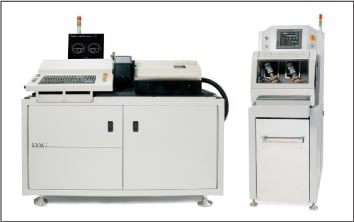eye on equipment
All on the Surface
Karlen McLean, ABOC, NCLC
Surfacing systems designed for small-to-midsized practices may look sleek, but they also offer ramped-up features that allow them to perform like their big cousins in larger lab environments.
Today's surfacing systems are faster and easier to use, with swifter job turnover that results in aesthetically pleasing, high-performance lenses.
Best of all, practices that already have or that are considering bringing in a surfacing component can benefit from equipment that's tailored for ECP offices, including cost effectiveness. Even free-form/digital surfacing is more practice-friendly now.

National Optronics' NOP Axiom
HIT THE GROUND RUNNING
Focusing on optical retailers and ECPs, new systems offering ground-level (pun intended) lens production are easier to understand and use.
Here's an overview of some current surfacing buzzwords and what they mean for your business.
AUTOMATIC: A simple entry or scan takes care of everything, including algorithms that set speed, pressure, and velocity to best suit lens material, curve, diameter, and topography. Or, push a few buttons on the screen menu for automatic operation. Several systems offer automated or manual modes, so you can run the process yourself if so desired.
COMPATIBLE: All generators should be compatible with the Optical Manufacturer's Association (OMA) and The Vision Council standards in order to be able to communicate effectively with the latest protocol and updates, as well as with third-party packages.
COMPLETE: Surfacing is considered an all-inclusive process, but not all surface generators may accomplish the complete lens process. Lens generating, cribbing, and pin-beveling in one step is one new standard for in-office surface generators.
FAST: Generally, today's generators offer around 30 percent faster turnaround than in the recent past and feature upgraded processors for faster generating speeds.
INTUITIVE: Today's surface generators use smart software and operation systems to help guide users via touch-screen procedures. The system can even make suggestions, such as the best lap to use to minimize waste and cutting time.
MENUS: Some surfacing systems offer menus, so you can choose options from standard Rx surfacing to challenging designs to free-form processing. Touch-screen selections offer a user-friendly experience.
PARAMETERS: The latest surface generators are able to process large lens blanks and non-typical work like high-powered Rx's, wraps, slab-offs, and other specialty lenses.
SMALL FOOTPRINT: Smaller is better; for example, one new surface generator is a tabletop model that's 21.5″H x 35.125″W and 28.625″D and weighs in at only 120 lbs (vacuum is 24 lbs). Smaller systems with big-system capabilities— including digital/free-form processing—are available for small-to-midsized businesses.
SOFTWARE: Integrated software drives new surfacing generators and helps simplify the process. Some models using 3-D imaging allow the designer (you) and your customer to visualize the lens before it is processed, which helps define expectations of the final product. EB
Logical LingoFollowing are some entry-level terms you'll need to “speak surfacing.” CAM: Computer Aided Manufacturing. Basically, software that helps CNC programmers create and run programs more easily. CNC: Computer Numerical Control. A type of machining controlled by computers. In addition to surfacing generators, for example, CNC technology is also used in metal fabrication, woodworking, and electrical industries. DNC: Distributive Numerical Control networks one or more CNC machines. Fining: Smooths lens surfaces in preparation for polishing. HMI: Human Machine Interface. An example is touch-screens that display operational information. Lap tool: Used to fine or fine and polish (hard lap) and/or polish (soft lap) lenses after surfacing (lathe). Lathe: A lathe cuts and puts curves on lens surfaces in readiness for fining. OMA: Indicates generator compliance with Optical Manufacturer's Association protocols, ensuring clear communications with latest protocols and third parties. 
DAC International's RxD Spectacle Generating Lathe |



